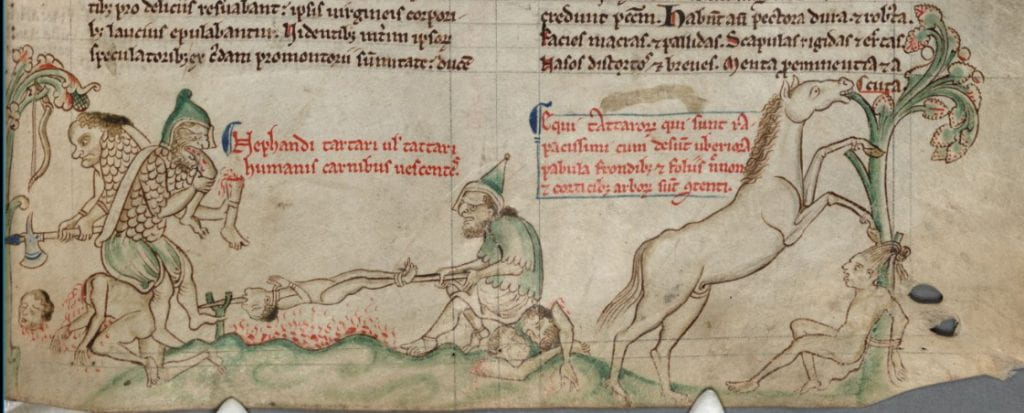Figure 6.1. Cannibalism in Brazil
Detail from Portulan (Weltkarte), 1502–6. Bayerische Staatsbibliothek, Munich, Cod.icon. 133.
This is the first scene of cannibalism in the Western Atlantic to appear on a map. This scene advances a highly negative argument about the customs of native peoples living in the lands across the Atlantic. The scene does not, however, visualize cannibalism the way that Vespucci presented it in his published Mundus Novos or Soderini letters. Rather, the scene has been imagined by a European artist who uses European imagery linked to cannibalism. For example, the illustration on the map is closer in representation to Matthew Paris’s scene of cannibalism in Chronica maior II (ca. 1240-55). The cannibalism scene appears in the text when Paris is describing the Mongol invasions of Eastern Europe. Paris depicts the feared Mongol warriors as consuming their defeated enemies both raw and cooked.
Detail, Matthew Paris, Chronica maiora II, Corpus Christi College Cambridge, MS 016II, 167v.
Once cannibalism appeared on a map or chart, it made a powerful argument about the nature of peoples living in the Americas. The prominent historian of historical cartography J. B. Harley has argued that “maps have helped to create some of the most pervasive stereotypes of our world,”* and cannibalism on maps is a prominent example. Historian Surekha Davies has found that cannibalism “was the most frequent motif for Brazil on maps well into the seventeenth century.”**
*J. B. Harley, “Texts and Contexts, in J. B. Harley and Paul Laxton, The New Nature of Maps: Essays in the History of Cartography (Baltimore, MD: Johns Hopkins University Press, 2001), 49.
**Surekha Davies, Renaissance Ethnography and the Invention of the Human: New Worlds, Maps and Monsters (Cambridge; New York: Cambridge University Press, 2016), 65.

